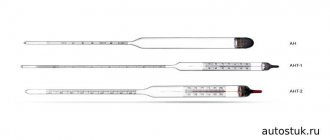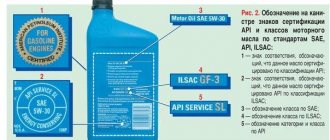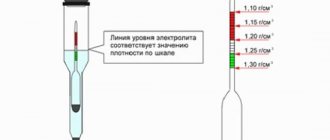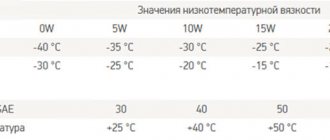Preface
The tasks, basic principles and rules for carrying out work on state standardization in the Russian Federation are established by GOST R 1.0-92 “State standardization system of the Russian Federation. Basic provisions" and GOST R 1.2-92 "State standardization system of the Russian Federation. The procedure for developing state standards"
Standard information
1 DEVELOPED by the State Scientific Metrological Center, Federal State Unitary Enterprise All-Russian Scientific Research Institute of Metrology named after D.I. Mendeleev (SSMC FSUE VNIIM named after D.I. Mendeleev), Closed Joint Stock Company "Caspian Pipeline Consortium-R", Open Joint Stock Company "Infrared microwave systems", Limited Liability Company "Technological Systems"
2 INTRODUCED by the Department of Metrology and Supervision of the Federal Agency for Technical Regulation and Metrology
3 APPROVED AND ENTERED INTO EFFECT by Order of the Federal Agency for Technical Regulation and Metrology dated December 28, 2004 N 130-st
4 This standard has been developed taking into account the provisions of the international standard ASTM D 1250 * “Standard Guide for Calculation Tables of Petroleum and Petroleum Products” ________________ * Access to international and foreign documents mentioned in the text can be obtained by contacting the User Support Service. — Note from the database manufacturer.
5 INTRODUCED FOR THE FIRST TIME
6 REPUBLICATION. January 2006
Information about changes to this standard is published in the “National Standards” index, and the text of the changes is published in the “National Standards” information indexes. In case of revision or cancellation of this standard, the relevant information will be published in the information index “National Standards”
1 area of use
This standard provides information on conversion tables for oil density values depending on temperature and pressure values (hereinafter referred to as the tables) contained in the recommendation [1], and examples of the use of these tables.
The tables are designed to bring the density of oil to specified temperatures, in particular to temperatures of 15° and 20°C, and pressure.
The tables should be used for accounting and settlement of commodity and commercial transactions with oil prepared for transportation through main oil pipelines, liquid transport for processing and (or) delivery for export.
Appendix A (for reference). Examples of using oil density conversion tables
Appendix A (reference)
A.1 The values of volumetric expansion coefficients and oil compressibility coefficients are determined from tables B.1 and B.2 [1]. Based on the values of density and temperature that fall within the corresponding ranges (in this standard they are highlighted with bold lines), the values of the coefficients of volumetric expansion and compressibility are determined.
Example - For oil having a density of 827.3 kg/m at a temperature of 28.5°C, the values of the coefficients of volumetric expansion and compressibility are determined.
The density value of 827.3 kg/m falls in the range of 825…829.99 kg/m, the temperature value of 28.5°C falls in the range of 25.0°C…29.99°C. From tables B.1 and B.2 [1] (Figures A.1 and A.2), the values of the coefficients of volumetric expansion and compressibility are determined. They are equal to 0.892·10°С and 0.810·10 MPa, respectively.
Figure A.1 — Excerpt from Table B.1
Figure A.1 — Excerpt from Table B.1 [1]
Figure A.2 - Fragment of table B.2
Figure A.2 - Fragment of table B.2 [1]
A.2 Recalculation of oil density depending on temperature for various test methods is carried out using tables B.3-B.10 [1].
To recalculate the density of oil, the following general procedures are performed:
Step 1. Round the temperature value to a higher multiple of 0.2°C, indicated in the column “°C”.
Step 2. Round the density value (hydrometer reading) to the nearest whole value in kg/m2 indicated in the head of the table.
Step 3. Calculate the difference between the rounded and measured (known) density values.
Step 4. Using tables B.3-B.10 [1], find the desired value of oil density at a temperature of 20°C, corresponding to the rounded values of temperature and density.
Step 5. If the temperature value is rounded to a higher value, subtract 0.1 kg/m from the density value obtained from the table (for tables B.3-B.6 and B.9-B.10 [1] ) or 0.1 kg/m is added to it (for tables B.7-B.8 [1]).
Step 6. Depending on how much the density value is rounded up or down, the density value is reduced or increased accordingly.
If the initial rounding of the density value to the nearest integer value (in step 2) is carried out upward, then the calculated density value is reduced by the same value.
If the initial rounding of the density value to the nearest integer value (in step 2) is carried out downward, then the calculated density value is increased by the same value.
Examples
1 Measurements of oil density were carried out using a hydrometer calibrated at a temperature of 20°C. Oil temperature: 27.5°C, hydrometer reading: 822.7 kg/m. Determine the density value at a temperature of 20°C.
The procedure for obtaining the density value at a temperature of 20°C is as follows:
Step 1. Round the temperature value up to a multiple of 0.2: 27.6°C.
Step 2. Round the hydrometer reading to the nearest whole value: 823 kg/m.
Step 3. Calculate the difference between the rounded and measured values of the hydrometer readings:
823-822.7=0.3 kg/m.
Step 4. Using Table B.3 [1] (Figure A.3), find the density value at a temperature of 20°C, corresponding to a temperature value of 27.6°C: 828.5 kg/m.
Step 5. Since the temperature value is rounded up, subtract 0.1 kg/m from the density value of 828.5 kg/m. The result is 828.4 kg/m.
Figure A.3 - Fragment of Table B.3
Figure A.3 - Fragment of table B.3 [1]
Step 6. Since the density value is rounded up by 0.3 kg/m, the density value of 828.4 kg/m is reduced by the same amount.
The desired density value at a temperature of 20°C: 828.1 kg/m.
2 Measurements of oil density were carried out using a hydrometer calibrated at a temperature of 20°C. Oil temperature: 32.2°C, hydrometer reading: 806.3 kg/m. Determine the density value at a temperature of 15°C.
The procedure for obtaining the density value at a temperature of 15°C is as follows:
Step 1. Round the hydrometer reading to the nearest whole value: 806 kg/m.
Step 2. Calculate the difference between the rounded and measured values of the hydrometer readings:
806-806.3=-0.3 kg/m.
Step 3. Using Table B.4 [1] (Figure A.4), find the density value at a temperature of 15°C, corresponding to a temperature value of 32.2°C and a density value of 807 kg/m: 818.7 kg/m.
Figure A.4 - Fragment of table B.4
Figure A.4 — Fragment of table B.4 [1]
Step 4. Since the density value is rounded down by 0.3 kg/m, the density value of 818.7 kg/m is increased by the same value.
The desired density value at a temperature of 15°C: 819.0 kg/m.
3 Measurements of oil density were carried out using a hydrometer calibrated at a temperature of 15°C. Oil temperature: 37.9°C, hydrometer reading: 843.6 kg/m. Determine the density value at a temperature of 20°C.
The procedure for obtaining the density value at a temperature of 20°C is as follows:
Step 1. Round the temperature value up to a multiple of 0.2: 38.0°C.
Step 2. Round the hydrometer reading to the nearest whole value: 844 kg/m.
Step 3. Calculate the difference between the rounded and measured values of the hydrometer readings:
844-843.6=0.4 kg/m.
Step 4. Using Table B.5 [1] (Figure A.5), for a temperature value of 38.0°C and a density value of 844 kg/m, find the density value: 856.5 kg/m.
Figure A.5 — Fragment of table B.5
Figure A.5 — Fragment of table B.5 [1]
Step 5. Since the temperature value is rounded up, subtract 0.1 kg/m from the density value of 856.5 kg/m. The result is 856.4 kg/m.
Step 6. Since the density value is rounded up by 0.4 kg/m, the density value of 856.4 kg/m is reduced by the same value.
The desired density value at a temperature of 20°C: 856.0 kg/m.
4 Measurements of oil density were carried out using a hydrometer calibrated at a temperature of 15°C. Oil temperature: 32.0°C, hydrometer reading: 856.2 kg/m. Determine the density value at a temperature of 15°C.
The procedure for obtaining the density value at 15°C is as follows:
Step 1. Round the hydrometer reading to the nearest whole value: 856 kg/m.
Step 2. Calculate the difference between the rounded and measured values of the hydrometer readings:
856-856.2=-0.2 kg/m.
Step 3. Using Table B.6 (Figure A.6), for a temperature value of 32°C and a density value of 856 kg/m, find the oil density value: 867.7 kg/m.
Figure A.6 - Fragment of table B.6
Figure A.6 - Fragment of table B.6 [1]
Step 4. Since the density value is rounded down by 0.2 kg/m, the density value of 867.7 kg/m is increased by the same value.
The desired density value at a temperature of 15°C: 867.9 kg/m.
The density of oil under standard conditions (temperature 20°C, excess pressure equal to zero) is 828.7 kg/m. The density value is determined at a temperature of 7.4°C.
The procedure for obtaining the density value is as follows:
Step 1. Round the density value to the nearest whole value: 829 kg/m.
Step 2. Calculate the difference between the rounded and known density values:
829-828.7=0.3 kg/m.
Step 3. Using Table B.7 (Figure A.7), for a temperature value of 7.4°C and a density value of 829 kg/m, find the density value: 838.3 kg/m.
Figure A.7 - Fragment of table B.7
Figure A.7 — Fragment of table B.7 [1]
Step 4. Since the density value is rounded up by 0.3 kg/m, the density value of 838.3 kg/m is reduced by the same value.
The desired density value at a temperature of 7.4°C: 838.0 kg/m.
6 The density of oil under standard conditions (temperature 15°C, excess pressure equal to zero) is 842.3 kg/m. Determine the density of oil at a temperature of 22.7°C.
The procedure for obtaining the density value is as follows:
Step 1. Round the temperature value to a multiple of 0.2°C: 22.8°C.
Step 2. Round the density value to the nearest whole value: 842 kg/m.
Step 3. Calculate the difference between the rounded and known density values:
842-842.3=-0.3 kg/m.
Step 4. Using Table B.8 (Figure A.8), for a temperature value of 22.8°C and a density value of 842 kg/m, find the density value: 836.3 kg/m.
Step 5. Since the temperature value is rounded up, 0.1 kg/m is added to the density value of 836.3 kg/m. The result is 836.4 kg/m.
Step 6. Since the density value is rounded down by 0.3 kg/m, the density value of 836.4 kg/m is increased by the same value.
Figure A.8 — Fragment of Table B.8
Figure A.8 - Fragment of table B.8 [1]
The desired density value at a temperature of 22.7°C: 836.7 kg/m.
7 Measurements of oil density were carried out using a laboratory density meter at an excess pressure of zero. Oil temperature: 62.8°C, density meter reading: 796.7 kg/m. The oil density value is determined under standard conditions (temperature 20°C, excess pressure equal to zero).
The procedure for obtaining the density value is as follows:
Step 1. Round the density meter reading to the nearest whole value: 797 kg/m.
Step 2. Calculate the difference between the rounded and measured density values:
797-796.7=0.3 kg/m.
Step 3. Using Table B.9 (Figure A.9), for a temperature value of 62.8°C and a density value of 797 kg/m, find the density value: 829.0 kg/m.
Figure A.9 — Fragment of table B.9
Figure A.9 — Fragment of table B.9 [1]
Step 4. Since the density value is rounded up by 0.3 kg/m, the density value of 829.0 kg/m is reduced by the same value.
The desired value of oil density at a temperature of 20°C: 828 kg/m.
8 The density of oil was measured with a laboratory density meter at an excess pressure of zero. Oil temperature: 37.3°C, density meter reading: 856.2 kg/m.
Determine the density value under standard conditions (temperature 15°C, excess pressure equal to zero).
The procedure for obtaining the density value is as follows:
Step 1. Round the oil temperature to a multiple of 0.2°C: 37.4°C.
Step 2. Round the density meter reading to the nearest whole value: 856 kg/m.
Step 3. Calculate the difference between the rounded and measured density values:
856-856.2=-0.2 kg/m.
Step 4. Using Table B.10 (Figure A.10), for a temperature value of 37.4°C and a density value of 856 kg/m, find the oil density value: 871.9 kg/m.
Figure A.10 — Fragment of table B.10
Figure A.10 — Fragment of table B.10 [1]
Step 5. Since the temperature value is rounded up, subtract 0.1 kg/m from the density value of 871.9 kg/m. The result is 871.8 kg/m.
Step 6. Since the density value is rounded down by 0.2 kg/m, the density value of 871.8 kg/m is increased by the same value.
The desired density value at a temperature of 15°C: 872.0 kg/m.
9 The density of oil at a temperature of 18.4°C and an excess pressure of 0.44 MPa is 818.9 kg/m. Determine the density value under standard conditions (temperature 20°C, excess pressure equal to zero).
Step 1. For oil having a density of 818.9 kg/m at a temperature of 18.4°C, the values of the coefficients of volumetric expansion and compressibility are determined.
The density value of 818.9 kg/m falls in the range of 815…819.99 kg/m, the temperature value of 18.4°C falls in the range of 15.0°C…19.99°C. From tables B.1 and B.2 [1] (Figures A.1 and A.2), the values of the coefficients of volumetric expansion and compressibility are determined. They are equal to 0.918·10°С and 0.810·10 MPa, respectively.
Step 2. Substitute into formula (12) the initial values of temperature and excess pressure, as well as the values of the coefficients of volumetric expansion and compressibility found from the tables and find
kg/m.
The desired density value at a temperature of 20°C and an excess pressure of zero: 817.4 kg/m.
10 The density of oil at a temperature of 21.1°C and an excess pressure of 2.44 MPa is 832.7 kg/m. The density value is determined at a temperature of 18.7°C and an excess pressure of 0.87 MPa.
Step 1. For oil having a density of 832.7 kg/m at a temperature of 21.1°C, the values of the coefficients of volumetric expansion and compressibility are determined.
The density value of 832.7 kg/m falls in the range of 830…835.99 kg/m, the temperature value of 21.1°C falls in the range of 20.0°C…24.99°C. From tables B.1 and B.2 [1] (Figures A.1 and A.2), the values of the coefficients of volumetric expansion and compressibility are determined. They are equal to 0.883·10°С and 0.784·10 MPa, respectively.
Step 2. Substitute into formula (12) the initial values of temperature and excess pressure, as well as the values of the coefficients of volumetric expansion and compressibility found from the tables and find
kg/m3.
The desired value of oil density at a temperature of 18.7°C and an excess pressure of 0.87 MPa: 833.4 kg/m3.
Properties of fuel oil
The composition and use of fuel oil are directly related to each other. It is a flammable viscous liquid of dark brown or black color. Specific physical and chemical properties are determined by the chemical composition of the original oil and the degree of distillation of distillate (gasoline, gas oil and kerosene) fractions. The main indicator of fuel oil is viscosity, which ranges from 8-80 mm2/s. It determines not only the purposes for which fuel oil will be used, but also the conditions for transporting the petroleum product, filling containers with it and subsequent draining. As the temperature drops, the viscosity increases, making pumping through pipes and draining from the container impossible without preheating.
In addition to viscosity, the following properties are important:
- Sulfur content – 0.5-3.5% (low sulfur – up to 0.5%, sulfur – up to 1%, high sulfur – up to 3.5%).
- Ash content – up to 0.3%.
- Pour point: 10-40 °C.
- Lower calorific value – 39.4-40.7 MJ/kg (high-calorie fuel).
Characteristics of different types of fuel oil
Each of the characteristics has standard values, since the ability to use fuel oil for its intended purpose depends on them. For example, the ash content should not exceed the specified level, since the ash generated during the combustion of fuel oil clogs the nozzles, which is why the equipment must be cleaned periodically. Ash also accelerates the corrosion of metal parts and negatively affects the environmental situation in the region. The amount of sulfur compounds is also limited due to toxicity and acceleration of corrosion processes.









